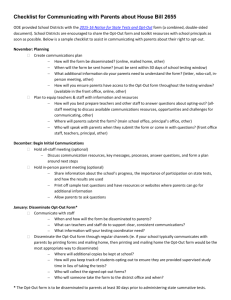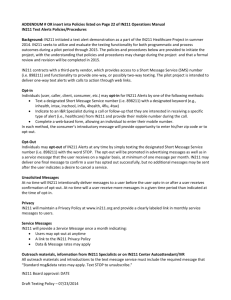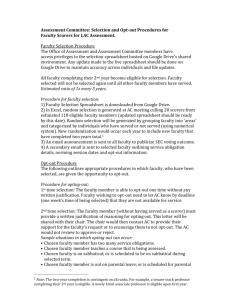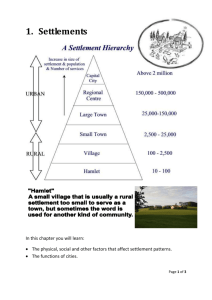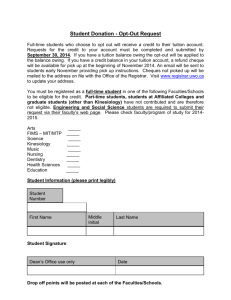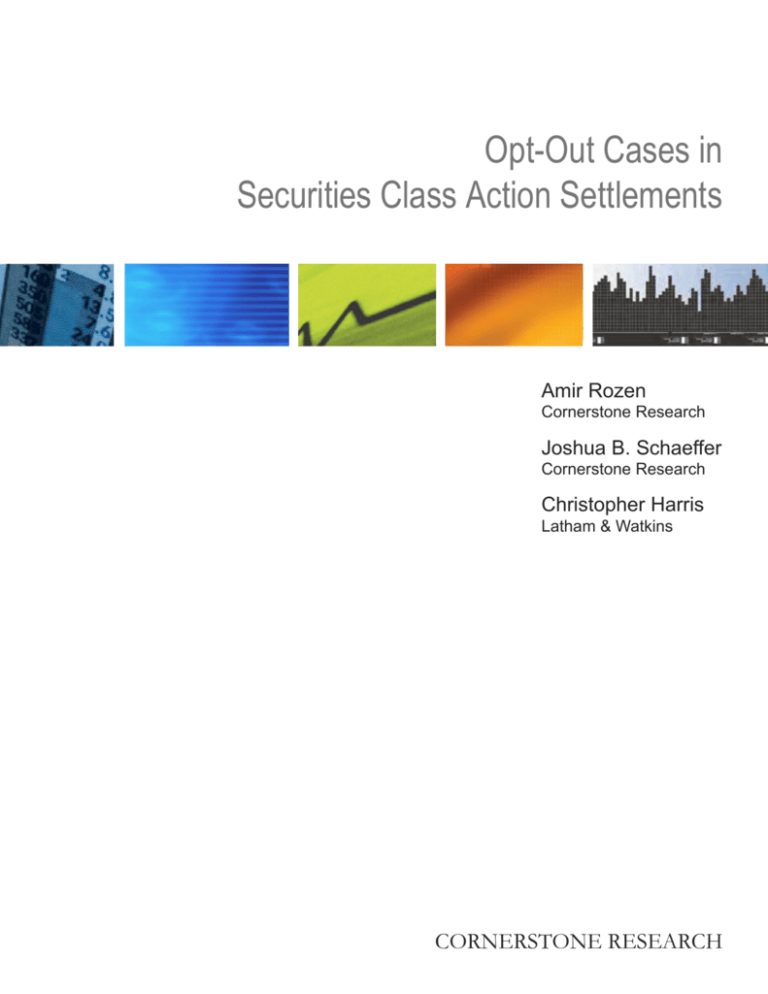
Opt-Out Cases in
Securities Class Action Settlements
Amir Rozen
Cornerstone Research
Joshua B. Schaeffer
Cornerstone Research
Christopher Harris
Latham & Watkins
CORNERSTONE RESEARCH
Opt-Out Cases in Securities Class Action Settlements
Introduction
This report provides, for what we believe is the first time, a comprehensive quantitative analysis of publicly available
lawsuits and settlements of so-called opt-out securities cases: cases in which at least one putative class member
excludes itself from the class in order to pursue a separate lawsuit against the defendant. We analyzed publicly
available information about the judgments and settlements that resulted from opt-outs from securities class action
settlements reached between 1996 and 2011. 1
Key Findings
•
Out of 1,272 securities class action settlements between January 1, 1996, and December 31, 2011, we identified 38
cases in which at least one plaintiff opted out of the class action settlement and pursued a separate case against the
defendant. We obtained opt-out settlement amount information in 21 of these 38 cases.
•
Plaintiffs are more likely to bring opt-out cases stemming from larger class action settlements: 53 percent of class
actions with class settlements of at least $500 million had at least one related opt-out case, compared with 3 percent
of all class action settlements.
•
Opt-out settlements represented an average of 12.5 percent of the value of the class action settlement, excluding optouts, and a median of 3.8 percent.
•
We identified six cases, the last of which settled in 2006, in which opt-out settlements represented more than
20 percent of the class action settlement value.
•
We found seven cases with opt-out settlements above $10 million, all related to class actions that settled between
November 2004 and November 2007.
•
The most frequently observed opt-out plaintiffs are pension funds, followed by other types of asset management
companies.
•
Based on limited anecdotal evidence, opt-out settlement plaintiffs may succeed in obtaining a larger recovery than
would have been received by remaining part of the class action (although the opt-out plaintiffs may also face higher
proportionate costs, and we have also identified instances where the opt-out plaintiff failed to recover any losses).
The research for this report was conducted jointly by Cornerstone Research and Latham & Watkins.
Opt-Out Cases in Securities Class Action Settlements | Page 1
Analysis of Opt-Out Cases
The great majority of securities class action cases result in either a dismissal or a settlement, with very few reaching a
trial verdict. 2 After a settlement is agreed upon, potential class members have the ability to opt out of the settlement. 3
Research addressing why plaintiffs opted out of and objected to class action settlements has found that the most
relevant predictor was the dollar amount recovered per class member. 4 Other research has reported that through the
period immediately after the adoption of the Private Securities Litigation Reform Act in 1995, most plaintiffs who
opted out did not do so in order to bring their own lawsuit. 5 More recently, however, studies have found that the
prevalence of opt-out cases—efforts to achieve a larger recovery through settlement or judgment outside of the class—
had increased from this period. 6 Our research builds on this by looking at the prevalence of opt-out cases over time and
analyzing these cases.
We have identified 38 cases in which at least one party from the putative class opted out and filed a separate suit
against the defendant, representing 3 percent of our sample of 1,272 cases. 7 We found no evidence of opt-out cases for
class actions that settled during the first two years of our sample, 1996 and 1997; however, the largest percentage rate
in our data occurred in 1998, with 10 percent of class action settlements having at least one subsequent opt-out case.
Two years, 2002 and 2006, each had the highest number in a given year, six opt-out cases. The table below shows the
number of opt-out cases per year in our analysis.
Number of Securities Opt-Out Cases
1996–2011
Percentage of OptOut Cases to Class
Action Settlements
Class Action
Settlement Year
Number of Class
Action Settlements
Number of
Opt-Out Cases
1996
1997
1998
1999
2000
2001
2002
2003
2004
2005
2006
2007
2008
2009
2010
2011
1
14
29
65
90
95
111
94
110
119
90
108
97
99
85
65
0
0
3
1
1
2
6
1
5
2
6
2
1
4
4
0
0.0%
0.0%
10.3%
1.5%
1.1%
2.1%
5.4%
1.1%
4.5%
1.7%
6.7%
1.9%
1.0%
4.0%
4.7%
0.0%
Total
1,272
38
3.0%
Source: Bloomberg, Factiva, Law360, PACER, Public Press, SEC Filings, Stanford Law School Securities Class Action Clearinghouse
Settlement Amount
In 21 of the 38 class action settlements with opt-out cases, the settlement or judgment amount for some or all of the optout cases was publicly available. The largest set of opt-out settlements related to a single case was AOL Time
Warner Inc., where the $764 million of opt-out settlements was 30.6 percent of the size of the class action settlement. 8
The largest opt-out settlement amount as a percentage of the class action settlement was Qwest Communications
International Inc., where the $411 million opt-out settlement was 92.4 percent of the final class action settlement. 9
Among cases with information available, the average total opt-out settlements were $85.4 million, or 12.5 percent of
the average class action settlement for these cases. These averages have been heavily skewed by the larger opt-out
settlements, as the median is only $3.9 million, or 3.8 percent of the related class action settlements.
Opt-Out Cases in Securities Class Action Settlements | Page 2
Prevalence
As class action settlements get larger, the propensity of plaintiffs to bring an opt-out case also increases. While a large
class action settlement does not guarantee opt-out cases, 10 percent of cases with class action settlements over
$20 million and eight of 15 cases with settlements over $500 million had associated opt-out cases. Conversely, for
class action settlements below $20 million, the opt-out case rate was only 0.9 percent. As there was never more than
one class action settlement greater than $500 million per year between 2008 and 2011, this may have driven the
relatively low number of opt-out cases in recent years. Based on our findings, if larger class action settlements are
reached in the future, more opt-out cases may be expected to emerge.
Size
In six cases, ranging from small (Critical Path Inc.’s $17.5 million class action settlement 10) to AOL Time Warner, the
opt-out settlements exceeded 20 percent of the size of the class action settlement. As of the time of this report, all of the
settlements in which the amount paid to opt-outs was greater than 5 percent of the class action settlement took place
prior to 2007.
The largest payments to opt-out plaintiffs we observed occurred in cases settled between October 2004 and December
2007. During this period, seven cases with opt-out settlements over $10 million were identified. The maximum
settlement to class opt-outs identified prior to this period was $6.4 million (settled by defendant Navigant Consulting
Inc. 11), and we did not identify any opt-out settlements greater than $10 million stemming from a class action
settlement after 2007.
Plaintiffs
We obtained information about the identity of plaintiffs in 34 of the 38 opt-out cases in our sample.
•
The most common plaintiffs in opt-out cases are pension funds. Pension funds were present in 16 of these 34 opt-out
cases during 1996 to 2011.
•
Seven of the 19 opt-out cases between 1996 and 2005 involved the Florida State Board of Administration.
•
Mutual funds, hedge funds, and other investment companies were involved in 14 opt-out cases.
•
Fifteen opt-out cases involved individual shareholders who were not identified as former employees or subsidiaries,
and four involved shareholders of companies that were bought by or otherwise affiliated with the defendant.12
Comparison to Class Action Recovery
There was not sufficient information available to compare the recovery as a percentage of alleged losses that the
plaintiffs in the 38 opt-out cases achieved with what those plaintiffs would have achieved had they stayed in the class.
Because the opt-out cases are not class actions requiring court approval to settle, but rather individual lawsuits, there is
much less information available on the settlements. In addition, many of the class action settlements’ records did not
provide information regarding the expected recovery as a percentage of alleged losses, nor final information about what
percentage recovery was ultimately achieved after claims were processed and expenses were deducted.
Opt-Out Cases in Securities Class Action Settlements | Page 3
Major Opt-Out Cases
This section provides anecdotal information regarding recoveries that opt-out cases achieved related to the class actions
against WorldCom Inc., AOL Time Warner, Qwest Communications International Inc., and Countrywide Financial
Corporation. 13 While to date cases with large opt-out recoveries represent the exception rather than the rule, there is no
mistaking the large impact that opt-outs can have on the total effect of a securities class action case.
WorldCom
In this matter, the law firm of Lerach, Coughlin, Stoia, Geller, Rudman & Robbins represented 65 investors who opted
out of a record $6.2 billion class action settlement in 2005, and instead pursued separate cases. 14, 15 Our research
identified opt-out settlements with various investors totaling $336.3 million, with many additional plaintiffs settling for
confidential amounts. 16
AOL Time Warner
Following the $2.4 billion settlement initially proposed in this matter in 2005, over 100 plaintiffs pursued a total of over
40 opt-out cases. 17 Based on figures reported to the press by opt-out plaintiffs and counsel, these cases settled for a total
of $764 million, obtaining far greater amounts than what plaintiffs would have received had they stayed in the class,
recovering up to 90 percent of investor losses. 18 The state of Alaska received an unusually large settlement—reportedly
50 times more than what would have been received without opting out. This has been attributed primarily to filing in
Alaska, which has favorable state-specific laws involving securities fraud. 19
Qwest Communications
The reported $411 million in total opt-out settlements in this matter exceeded the originally proposed class action
settlement amount of $400 million, and was more than 90 percent of the final settlement of $445 million. 20 The
Colorado Public Employees’ Retirement Association (Colorado PERA) received a settlement reported to be
approximately 38 times the size of what would have been received without opting out. Colorado PERA also stated that
attorney’s fees were 5 percent of the settlement, compared with 15 percent for the class. 21
Countrywide Financial
One of the provisions in this settlement 22 reduced the amount of the class action settlement in order to provide funds for
the defendants to pay settlements or judgments from opt-out cases. The settlement fund was established at
$624 million, paid by Countrywide parent Bank of America Corporation and auditor KPMG LLG. The settlement
agreement provided that the settlement fund would be reduced by the pro-rata share of any opt-outs, capped at
$22.5 million; that amount could only be used to pay for opt-out cases, and if it was not all used the amount would be
returned to the class action settlement fund and distributed to the participating class members. 23 Based on the actual
percentage of opt-outs, the set-aside was expected to reach the cap and provide an amount equal to less than half of the
estimated recovery that the opt-out plaintiffs would have achieved by staying in the class. However, this did not limit
the potential recoveries of the opt-out plaintiffs, many of whom settled for confidential amounts. 24
Opt-Out Cases in Securities Class Action Settlements | Page 4
Considerations for Opting Out and the Impact on the Class Action
As prior research has noted, one of the main reasons that class action participants elect to opt out and pursue individual
cases is the potential for financial improvement of the outcome. 25 The median recovery rate for class actions is
approximately 3 percent of estimated investor losses, 26 which has been attributed partly to limited monitoring of the
attorneys and a fee structure that incentivizes attorneys to try to settle the case quickly. 27 Further, for cases with larger
estimated total damages, the class recovery rate tends to be smaller. 28 Another possible reason for opting out may be to
bring a lawsuit in state court (such as what occurred in the state of Alaska in AOL Time Warner), which the opt-out
plaintiffs might believe would provide a speedier trial process or a sympathetic local judge and jury pool. 29
The class action related to Marsh & McLennan Companies Inc. 30 shows that just the threat of an opt-out can be a
powerful tool for plaintiffs. In this case, a small group of stockholders initially indicated their intent to opt out of the
settlement, but later agreed to opt in for an additional $25 million payment. 31 The total class settlements for the
securities and related ERISA lawsuits were $435 million, which would have provided a class payment of
approximately $17.4 million to these stockholders absent the threatened opt-out. 32 Because these shareholders did not
opt out of the final settlement, this case is not included in our sample of 38 opt-out cases.
The better recovery hoped for by plaintiffs, however, may not materialize. For instance, following a recent opt-out by
Gabelli Asset Management Inc. from the Vivendi Universal S.A. class action, 33 the judge dismissed the opt-out case on
the ground that the plaintiff did not rely on the alleged misrepresentations and omissions. 34 The class action plaintiffs,
however, won at trial. 35 Because this was a trial verdict and not a settlement, it is not included in our sample of
38 opt-out cases. Likewise, following the $5.6 million Aspen Technology Inc. class action settlement, several plaintiffs
opted out and pursued separate cases. 36 In 2010, almost two years after the class action settlement was distributed, one of
the opt-out cases was dismissed when a judge ruled that the defendants had not committed fraud. 37 In addition to giving up
their share of the class action settlement in order to opt out, the plaintiffs were forced to pay the defendant’s legal fees. 38
There are other potential considerations for the opt-out plaintiff besides the amount of recovery. Because opt-out cases
are smaller, the proportion of attorney’s fees and other expenses (such as expert fees) that plaintiffs have to pay out of
pocket may be higher (although, as noted above in the Qwest Communications settlement, one opt-out plaintiff claims
to have paid a lower percentage attorney fee than the class did). Because legal expenses, such as attorneys’ fees, filing
fees, and discovery and expert expenses, are spread out among fewer plaintiffs than in a class action, individual
plaintiffs may not wish to bring an opt-out case unless their losses are sufficiently deep to justify the subsequent legal
costs. Individual plaintiffs also face a much greater possibility of depositions and discovery than had they simply
remained unnamed class members. Furthermore, if opt-out trials are pursued in state courts, this may have
disadvantages, as these courts may have less experience with securities fraud cases and possibly different rules of
discovery and damages. 39
An increase in opt-out cases could have significant effects on class action settlements, causing them to fail by triggering
blow-out provisions in the class action settlements. These provisions allow the termination or renegotiation of the class
action settlement by the defendant if a large enough portion of the class opts out. In addition, class action settlements
can include governance changes, such as increasing board openness and disclosure, auditing policies, and reviewing
executive compensation. 40 In an opt-out case, however, the role of governance in negotiations may be smaller, thus
potentially lowering the impact of governance changes, and instead increasing the need for cash payments. 41 In addition,
if larger shareholders are expected to opt out of a settlement, defendants may offer less money to settle with the class. 42
This could result in a two-tiered settlement, in which smaller shareholders are significantly disadvantaged. It could also
cause defendants to have less incentive to settle the class actions, and instead increase the likelihood of trials.
Opt-Out Cases in Securities Class Action Settlements | Page 5
Conclusion
It appears that defendants will need to continue to consider opt-out cases as an issue, especially for large securities
cases, as 53 percent of class actions with settlements above $500 million had opt-out cases. Litigants in securities class
actions should consider the impact of opt-out cases, as these settlements can add additional costs to the class action
settlement. In the average case with an opt-out, an additional 12.5 percent is paid to plaintiffs who opted out, and in six
cases, more than 20 percent was paid to these plaintiffs. One additional factor to consider for the likelihood of opt-out
cases is the portion of shares held by pension funds and other institutional investors, which file a majority of opt-out
cases.
Opt-Out Cases in Securities Class Action Settlements | Page 6
Endnotes
1
The results presented throughout this report are based on a review of publicly available information from public press articles,
Securities and Exchange Commission (SEC) filings, and court documents for 1,272 securities class action settlements
between 1996 and 2011. Potential settlement class opt-outs and subsequent related cases were identified by reviewing public
press articles one year before and after the class action settlement hearing date, and company SEC Form 10-K and Form 10-Q
filings two years before and after the class action settlement hearing date. An initial SEC filings and public press search was
carried out for each company in the database. Key search terms included “opt-out,” “exclude,” and “individual action.” Cases
where key search terms were found were further reviewed based on a wider date range of public filings, public press, legal
journal, and Internet searches. In those cases where search terms were found, if the list of plaintiffs was available in the court
docket through PACER, the list of plaintiff names was searched in subsequent public filings, in order to find any future
lawsuits filed by opt-out plaintiffs. Because opt-out information is not necessarily available until after the settlement, 2012
and 2013 class action settlements were not considered at this point. While multiple parties may opt out and file lawsuits
together or separately, for the purpose of this analysis we consider the collective opt-outs from a single case except where
specifically noted. Similarly, while each case may have multiple defendants, we refer to them collectively as the defendant.
2
Securities Class Action Filings—2012 Year in Review, Cornerstone Research, 2013.
3
Plaintiffs can opt out from the class action even prior to the date on which a settlement has been reached with the class.
Plaintiffs can also opt out from those cases that go to trial verdicts rather than settlement. For example, we found two class
action cases, which are not part of our sample and excluded from our statistics, where trial verdicts were reached in which
plaintiffs have opted out from the class actions. In one of these cases, a confidential settlement with defendant Apollo
Group Inc. was reached. In the other, relating to Vivendi Universal S.A., the opt-out plaintiff lost at trial. This case is
discussed in more detail later.
4
Theodore Eisenberg and Geoffrey Miller, “The Role of Opt-Outs and Objectors in Class Action Litigation: Theoretical and
Empirical Issues,” Vanderbilt Law Review 57 (2004).
5
John Coffee Jr., “Accountability and Competition in Securities Class Actions: Why ‘Exit’ Works Better Than ‘Voice,’”
Cardozo Law Review 30, no. 2 (2008). In these situations, the opt-outs typically increase the recovery to remaining class
members.
6
For example, see Kevin LaCroix, “Opt-Outs: A Worrisome Trend in Securities Class Action Litigation,” Oakbridge InSights
2, no. 3 (April 2007): 1.
7
For more details on the 1,272 securities class action settlements analyzed, see Securities Class Action Settlements—2011
Review and Analysis, Cornerstone Research, 2012.
8
In re AOL Time Warner Inc. Securities and “ERISA” Litigation. Complaint filed August 23, 2004. Settlement hearing date
April 6, 2006.
9
New England Health Care Employees Pension Fund et al. v. Qwest Communications International Inc. et al. Complaint filed
February 6, 2004. Settlement hearing date September 29, 2006.
10
In re Critical Path Inc. IPO Securities Litigation. Complaint filed August 31, 2001. Settlement hearing date May 23, 2002.
11
Stearns et al. v. Navigant Consulting Inc. et al. Complaint filed November 23, 2009. Settlement hearing date March 22, 2001.
12
Many cases involve multiple opt-outs among various types of plaintiffs.
13
We were not able to obtain information for the entire sample regarding recoveries that opt-out cases achieved.
14
In re WorldCom Inc. Securities Litigation. Complaint filed December 1, 2003. Settlement hearing date September 9, 2005.
15
Kevin LaCroix, “Opt-Outs: A Worrisome Trend in Securities Class Action Litigation,” Oakbridge InSights 2, no. 3, (April
2007): 1.
16
Based on public press reports, court documents, and SEC filings.
17
Based on public press reports, court documents, and SEC filings.
18
For example, see Josh Gerstein, “Time Warner Case Finds a Surprise,” New York Sun, December 7, 2006,
http://www.nysun.com/national/time-warner-case-finds-a-surprise/44761/, and “CalPERS’ Time Strategy Pays Off: The State
Pension Fund Gets $117.7 Million after Opting Out of Class-Action Suit against Media Giant,” Sacramento Bee, March 15,
2007.
Opt-Out Cases in Securities Class Action Settlements | Page 7
19
Josh Gerstein, “Time Warner Case Finds a Surprise,” New York Sun, December 7, 2006,
http://www.nysun.com/national/time-warner-case-finds-a-surprise/44761/.
20
“Company and Case Information: Qwest Communications International Inc.,” Stanford Law School Securities Class Action
Clearinghouse, accessed July 9, 2013, http://securities.stanford.edu/1019/Q01/.
21
“Colorado PERA Reaches $15.5 Million Settlement with Qwest,” Colorado Public Employees’ Retirement Association Press
Release, November 21, 2007, http://www.copera.org/pdf/NewsReleases/2007/Qwest.pdf.
22
In re Pappas et al. v. Countrywide Financial Corp. et al. Complaint filed January 7, 2009. Settlement hearing date December
14, 2010.
23
First Amendment to Amended Stipulation and Agreement of Settlement, In re Countrywide Financial Corporation Securities
Litigation, No. CV 07-05295 MRP (MANx) (C.D. Cal. Jan. 4, 2011), at 2; Reporter’s Transcript of Motion for Final
Approval of Proposed Settlement and Allocation of Net Settlement Funds and Petition of Lead Counsel for Lead Plaintiffs for
an Award of Attorney’s Fees and Reimbursement of Expenses, In re Countrywide Financial Corporation Securities
Litigation, No. CV 07-05295 MRP (MANx) (C.D. Cal. Feb. 25, 2011), at 16.
24
Edvard Pettersson, “Bank of America Settles Countrywide Fraud Claims by Calpers,” Bloomberg, November 22, 2011,
http://www.bloomberg.com/news/2011-11-22/bank-of-america-settles-countrywide-fraud-claims-with-calpers.html.
25
For example, see Kevin LaCroix, “Opt-Outs: A Worrisome Trend in Securities Class Action Litigation,” Oakbridge InSights
2, no.3 (April 2007): 1.
26
Securities Class Action Settlements—2012 Review and Analysis, Cornerstone Research, 2013.
27
John Coffee Jr., “Accountability and Competition in Securities Class Actions: Why ‘Exit’ Works Better Than ‘Voice,’”
Cardozo Law Review 30, no. 2 (2008): 407, 414.
28
Securities Class Action Settlements—2012 Review and Analysis, Cornerstone Research, 2013.
29
Because many opt-out cases are filed by government pension funds in their home state, against firms operating in other states,
the “home-court advantage” of these cases may be substantial. See John Coffee Jr., “Accountability and Competition in
Securities Class Actions: Why ‘Exit’ Works Better Than ‘Voice,’” Cardozo Law Review 30, no. 2 (2008): 432.
30
In re Marsh & McLennan Companies Inc. Securities Litigation. Complaint filed March 13, 2007. Settlement hearing
December 23, 2009.
31
Marsh & McLennan Companies Inc., SEC Form 10-K, filed February 26, 2010.
32
Based on the SEC Form 10-K, the shareholders held approximately 4 percent of the eligible stock. Applying this percentage
to the $435 million settlement results in a value of $17.4 million.
33
In re Vivendi Universal S.A. Securities Litigation. Complaint filed November 24, 2003.
34
GAMCO Investors Inc. v. Vivendi S.A., No. 03 Civ. 5911 (SAS) (S.D.N.Y. Feb. 28, 2013).
35
David Glovin and Don Jeffrey, “Vivendi Found Liable on All 57 Counts in Investors’ Class Suit,” Bloomberg, January 30,
2010, http://www.bloomberg.com/apps/news?pid=conewsstory&tkr=VIVDY:US&sid=a9Js0VPRJWzw.
36
In re Aspen Technology Inc. Securities Litigation. Complaint filed August 26, 2005. Settlement hearing March 6, 2006. SEC
Filings.
37
Finding of Fact, Rulings of Law, and Order for Judgment after Jury-Waived Trial, Blecker v. Aspen Technology Inc. et al.,
No. 06-2357-BLS2 (Mass. Super. Ct. Jan. 13, 2010).
38
“Aspen Technology Secures Victory in Securities Fraud Case,” Skadden, Arps, Slate, Meagher & Flom, January 21, 2010,
http://www.skadden.com/news-events/aspen-technology-secures-victory-securities-fraud-case.
39
Bruce Carton, “Puncturing the Myths of Opting Out,” ISS Securities Litigation Watch, December 12, 2003,
http://web.archive.org/web/20060506151816/http://slw.issproxy.com/securities_litigation_blo/2003/12/puncturing_the_.html.
40
Luke Green, “Governance Reforms through Securities Class Actions,” Institutional Shareholder Services Inc., October 17,
2011, http://www.issgovernance.com/files/private/GovernanceReformsSecuritiesLitigation20111017.pdf.
41
Bruce Carton, “Puncturing the Myths of Opting Out,” ISS Securities Litigation Watch, December 12, 2003,
http://web.archive.org/web/20060506151816/http://slw.issproxy.com/securities_litigation_blo/2003/12/puncturing_the_.html.
42
John Coffee Jr., “Accountability and Competition in Securities Class Actions: Why ‘Exit’ Works Better Than ‘Voice,’”
Cardozo Law Review 30, no. 2 (2008): 435.
Opt-Out Cases in Securities Class Action Settlements | Page 8
About the Authors
Amir Rozen is a principal in the New York office of Cornerstone Research, where he consults on litigation involving
complex financial economics and accounting issues, including asset pricing, mortgage-backed securities, valuation,
financial statement analysis, taxes, employee stock options, portfolio performance, insider trading, corporate
governance, and corporate finance. Mr. Rozen specializes in matters related to class certification, market efficiency,
loss causation, and damages.
Joshua B. Schaeffer is a senior economist in the New York office of Cornerstone Research, where he specializes in
applying financial and economic theory to cases involving securities and valuation. Dr. Schaeffer has modeled and
examined damages for multiple class action securities cases. He also has significant experience in the valuation of
complex equity instruments.
Christopher Harris is a partner in the New York office of Latham & Watkins, where he served for three years as
cochair of the litigation department. Mr. Harris has represented all of the major accounting firms in civil, regulatory,
and criminal matters. He has also represented issuers in multiple-billion dollar securities litigations, securities firms and
individuals in SEC investigations, and outside directors of investment banks and issuers in securities class actions and
derivative actions.
The opinions expressed in this report are solely those of the authors and do not necessarily reflect the views of
Cornerstone Research or Latham & Watkins.
Opt-Out Cases in Securities Class Action Settlements | Page 9
The authors request that you reference Cornerstone Research and Latham & Watkins in
any reprint of the information included in this study. Please direct any questions to:
Amir Rozen
Cornerstone Research
212.605.5068
arozen@cornerstone.com
Christopher Harris
Latham & Watkins
212.906.1880
christopher.harris@lw.com
Cornerstone Research
For more than 25 years, Cornerstone Research staff have provided economic and financial analysis and expert testimony in all
phases of complex litigation and regulatory proceedings. The firm’s industry-leading research is recognized for its innovative
reporting on securities class actions and modeling of settlement outcomes. Cornerstone Research staff have expertise in trade
execution and pricing, risk management, market microstructure, public and private equity and fixed income, structured finance,
and derivatives. Cornerstone Research has 450 staff and offices in Boston, Chicago, Los Angeles, Menlo Park, New York,
San Francisco, and Washington.
www.cornerstone.com
Latham & Watkins LLP
Latham & Watkins is a global law firm with approximately 2,100 lawyers in its offices located in the world’s major financial, business
and regulatory centers in Asia, Europe, the Middle East and the United States. Among Latham’s wide spectrum of expertise in
transactional, litigation, corporate and regulatory areas, Latham’s Securities Litigation & Professional Liability Practice Group has
successfully advised on some of the most high-profile actions filed since passage of the 1995 Private Securities Litigation Reform Act
handling more than 1,000 cases during the past decade.
www.lw.com
© 2013 by Cornerstone Research, Inc. All Rights Reserved.
Cornerstone Research is a registered service mark of Cornerstone Research, Inc. C logo and design is a registered trademark of Cornerstone Research, Inc.

